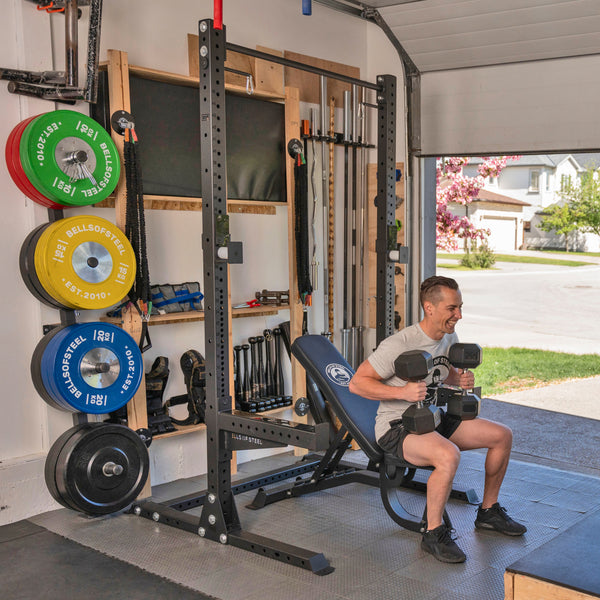So, you’ve got a spare room collecting dust, mismatched furniture, and maybe a few haunted vibes from your last attempt at a DIY office. It’s time for a glow-up—home gym edition.
Here’s the truth: you don’t need a three-car garage or a backyard shed to build a swole sanctuary. The Bells of Steel community is known for squeezing full-blown strength setups into laundry rooms, basements, closets, and even apartments with curious neighbors and creaky floors.
This guide will walk you through exactly how to turn your spare room into a strength training paradise—without making your house look like it joined a bodybuilding cult. Unless that’s the aesthetic. No judgment.
Why Build a Home Gym in a Spare Room?
Because commuting to the gym stinks, sharing sweaty benches with strangers is overrated, and your gains should never be held hostage by holiday hours. A spare room gym saves time, money, and your sanity—especially when leg day calls and motivation is playing hard to get.
Plus, a home gym can be customized to your goals, your budget, and your space (even if that space used to be your cat’s personal sunbathing studio).
Step 1: Measure Twice, Deadlift Once
Assess Your Space
Break out the measuring tape and channel your inner contractor. Knowing the room dimensions will help you pick the right gear without accidentally creating a squat rack/door collision zone.
Watch out for:
-
Ceiling height (especially for pull-ups or overhead presses)
-
Flooring (carpet is a no-go for stability)
-
Outlets (because your treadmill isn’t battery-operated)
-
Door clearance (unless you like lifting with the door open to the hallway drama)
Step 2: Choose Equipment That Packs a Punch
The Must-Haves
You don’t need to go full commercial gym to get jacked. Start with compact, versatile gear:
-
Adjustable Dumbbells – Save space, still crush curls.
-
Adjustable Bench – Flat, incline, decline—because angles matter.
-
Resistance Bands – Warm-up, mobility, and spice for leg day.
-
Barbell & Plates – The meat and potatoes of any strength setup. Choose a short barbell for big lifts in minimal spaces.
-
Squat Stand or Power Rack – Bonus points if it’s foldable or wall-mounted.
-
Flooring – Foam tiles, rubber mats, or a customizable weightlifting platform to protect your joints and your floor (and your security deposit, if renting).
The Heavy Hitters
Got more room (or ambition)? Consider adding:
-
Bells of Steel Hydra Rack – Modular magic for racks with brains and brawn. Space-savvy configurations are available.
-
Cable Tower – Plate-loaded or stack-loaded options to unlock rows, curls, and pulldowns. This add-on is also a space-friendly addition with an itty bitty footprint.
-
Belt Squat Machine – Squat without loading your spine.
-
Leg Press/Hack Squat Machine – For serious quad carnage in compact form.
-
Smith Machine – Safety and gains on rails. Mounts directly to your Hydra or Manticore power rack.
Step 3: Optimize Layout for Function & Flow
Zoning is Key
Even in a small room, layout matters. Group similar movements together:
-
Lift Zone: Rack, bench, barbell, plates.
-
Cardio Corner: Rower, treadmill, or Blitz Air Bike.
-
Stretch & Cooldown: Foam roller, bands, yoga mat—aka the recovery corner (where you'll definitely stretch... eventually).
Mount storage on the wall to keep the floor clear. Think plate trees, dumbbell racks, or wall-mounted bar holders. Vertical space is your new best friend.
Step 4: Light It Up & Get Motivated
Gym Vibes Matter
Don’t forget the intangibles. Paint the walls. Add a mirror to check form and admire the pump. Hang up posters (or Bells of Steel Flags) that scream “lift things!” and blast playlists that make you want to PR your warm-up set.
And for the love of gains, install some decent lighting. No one wants to max out in a room that feels like a murder mystery scene.
Step 5: Beat the Challenges Before They Start
Common Hurdles (And How to Outlift Them)
-
Noise Control: Invest in rubber flooring, use bumper plates, and consider headphones over blasting metal at midnight.
-
Ventilation: A fan or portable AC unit keeps things cool when your sets are heating up.
-
Storage: Pick multi-purpose equipment (like an All-in-One Trainer) and keep things tidy between sessions. Lifting in chaos is not hardcore—it’s just hazardous.
-
Floor Damage: Don’t test your hardwood. Use mats, especially under racks and where you drop weights.
FAQs About Building a Spare Room Home Gym
Q: Can I really fit a gym in a small bedroom?
A: Absolutely. With the right equipment (like compact racks, adjustable dumbbells, and wall-mounted storage), you can turn a tiny bedroom into a big lifting win.
Q: Will the floor handle the weight?
A: Most standard floors can handle typical home gym setups. But avoid dropping weights like you're Thor unless you're on ground level or reinforced flooring. When in doubt, talk to a professional contractor.
Q: How do I hide a home gym when guests come over?
A: Foldable benches, wall-mounted racks, and clever storage make it easy to flip your gym back into a guest room. Bonus: your in-laws probably won’t ask to stay too long if it smells like chalk and hard work.
Q: Can I do cardio in a spare room setup?
A: Yep! Jump rope, step-ups, or even compact machines like the Bells of Steel Dreadmill or Blitz Bike all fit nicely. Just make sure you don’t knock over a lamp in the process.
Spare Room, Swole Goals
You don’t need a mansion or fancy garage gym to get strong. You just need a spare room, a game plan, and maybe a squat rack that folds tighter than your favorite hoodie. With the right setup, you’ll have a space that motivates you to lift, recover, and do it all over again—no commute required.
So go ahead. Reclaim that forgotten room from dusty storage and cat naps. Your dream gym is only a few reps (and some well-placed mats) away.



